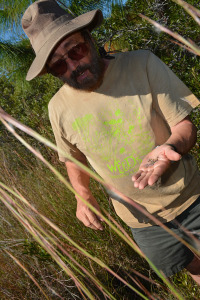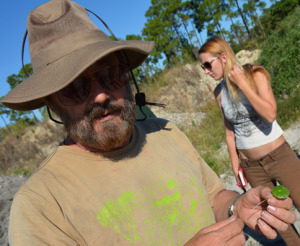Eat the Weeds
by Nancy B. Loughlin
Published November 4, 2014. Posted with permission.
To you, they’re weeds, and you want them dead.
Instead of enlisting toxic herbicides, perhaps you could eat them.
Technically, a weed is defined as any plant that grows where you don’t want it. For Green Deane, master forager and author, weeds get a bad rap. For the last 20 years, he’s been spreading the word that many weeds are not only delicious; they are nutritious, abundant, free and sustainable.
“I eat something wild every day,” he said.
Green Deane recently led a Sunday foraging expedition for Florida Gulf Coast University (FGCU) environmental studies students right on the Fort Myers campus. Edible plants are ubiquitous in FGCU’s lush food forest, and they also flourish along the campus roadways, construction sites and nature trails. For hours, Green Deane identified numerous edibles including peppery greens, creeping cucumber, berries and grapes.
“We’re always surrounded by food,” he said.
There are, obviously, many cautions that go along with foraging for wild food. “Use your brain,” he said, and learn something about plants.
The first rule is to NEVER eat a wild plant without consulting a local expert.
There are over 1,000 edible plants indexed on Green Deane’s website (www.EatTheWeeds.com), but there are also many deadly plants out there. This can be overwhelming for a novice forager.
Green Deane suggests starting with the rule of fours: identify four edibles, four medicinal plants and four toxic plants. Use these 12 plants as your baseline, and then expand your knowledge with expert guidance. Green Deane estimates that 93% of the plants out there are not edible.
What are the two biggest mistakes beginners make? According to Green Deane, new foragers try to identify every plant they see, or they try to make every plant fit a guidebook’s description. Thus, a teacher is a good idea.
In addition to foraging weeds, Green Deane also suggests cultivating your own weed garden.
Weed Garden Method One: Dig up a section of your lawn. That’s it.
Weeds thrive in disturbed soil. Yes, seeds sprout after they travel by air, bird poop or the bottoms of shoes. But there is also a smorgasbord of seeds that has been lying dormant for years in the earth, and those seeds may accept your invitation to sprout.
What wild food might make an appearance in a typical SW Florida yard?
According to Green Deane, with the help of an expert, you might identify Bidens alba (its tender, young leaves are a nice addition to salads); sow thistles (resemble lettuce); Poor Man’s Peppergrass (it has the bite of arugula); and purslane (a fine salad on its own).
Weed Garden Method Two: Go foraging for seeds.
Green Deane checks out mounds of soil in city parks, country roadsides, land that has been cleared for housing developments (where the houses have yet to show up) and construction sites where soil piles haven’t moved for a month. Good foraging sites are not downhill from parking lots. They are also at least several hundred feet away from the Interstate.
Green Deane’s Top Seeds: the darkened fruit of creeping cucumber, passion flowers, fireweed, dandelions and amaranth.
Visit Green Deane’s website, www.EatTheWeeds.com, for a full index of edible plants, video links, recipes and foraging tips.


